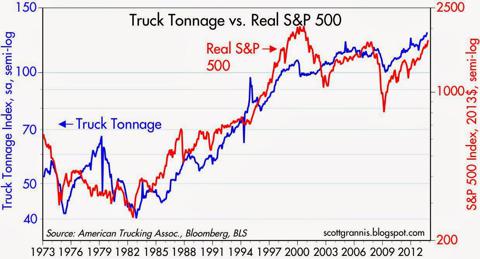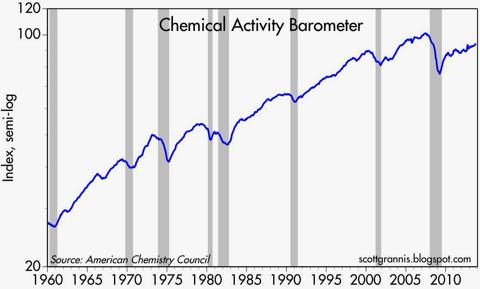The real value of the stock market is positively correlated, over time, with the amount of freight hauled by the nation’s trucks (in other words, the physical size of the economy has a lot to do with the real, inflation-adjusted value of the economy) and the latest numbers (see chart) strongly suggest that we are not in a stock market bubble.
amount of freight hauled by the nation’s trucks (in other words, the physical size of the economy has a lot to do with the real, inflation-adjusted value of the economy) and the latest numbers (see chart) strongly suggest that we are not in a stock market bubble.
[The following article is presented by Lorimer Wilson, editor of www.FinancialArticleSummariesToday.com and www.munKNEE.com and the FREE Market Intelligence Report newsletter (sample here – register here) and may have been edited ([ ]), abridged (…) and/or reformatted (some sub-titles and bold/italics emphases) for the sake of clarity and brevity to ensure a fast and easy read. This paragraph must be included in any article re-posting to avoid copyright infringement.]
(click to enlarge) Truck tonnage in September hit another all-time high, up 8.4% in the past year, and up almost 30% since the economy began to recover in mid-2009. The physical economy is apparently growing much faster than the official GDP statistics suggest (real GDP growth has been about 2% per year during the current recovery). This is comforting, to say the least, and, as the chart shows, since the real value of the stock market hit its all-time high in early 2000, the economy has improved dramatically, while stocks are still struggling to regain their previous high. If stocks were in bubble territory back then, it’s far less likely that they’re in bubble territory today. As Calculated Risk notes, the strong performance of the trucking industry owes much to the “robustness to the sectors of the economy that are growing fastest, like housing construction, auto production, and energy output. These industries produce heavier than average freight, which leads to faster growth in tonnage versus a load or shipment measure.” UPDATE: The Chemical Activity Barometer also shows increased physical activity, which at the very least rules out a recession: (click to enlarge)
Truck tonnage in September hit another all-time high, up 8.4% in the past year, and up almost 30% since the economy began to recover in mid-2009. The physical economy is apparently growing much faster than the official GDP statistics suggest (real GDP growth has been about 2% per year during the current recovery). This is comforting, to say the least, and, as the chart shows, since the real value of the stock market hit its all-time high in early 2000, the economy has improved dramatically, while stocks are still struggling to regain their previous high. If stocks were in bubble territory back then, it’s far less likely that they’re in bubble territory today. As Calculated Risk notes, the strong performance of the trucking industry owes much to the “robustness to the sectors of the economy that are growing fastest, like housing construction, auto production, and energy output. These industries produce heavier than average freight, which leads to faster growth in tonnage versus a load or shipment measure.” UPDATE: The Chemical Activity Barometer also shows increased physical activity, which at the very least rules out a recession: (click to enlarge)
[Editor’s Note: The author’s views and conclusions in the above article are unaltered and no personal comments have been included to maintain the integrity of the original post. Furthermore, the views, conclusions and any recommendations offered in this article are not to be construed as an endorsement of such by the editor.]
Related Articles:
 munKNEE.com Your Key to Making Money
munKNEE.com Your Key to Making Money


